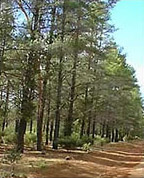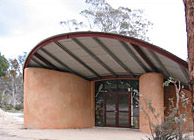Dryandra State Forest
 Dryandra Woodland covers a total of 28,000 hectares, with 17,500 hectares being in the Cuballing Shire. The seventeen separate bush blocks that make up Dryandra Woodland are among the largest and most valuable for nature conservation in the central western Wheatbelt.
Dryandra Woodland covers a total of 28,000 hectares, with 17,500 hectares being in the Cuballing Shire. The seventeen separate bush blocks that make up Dryandra Woodland are among the largest and most valuable for nature conservation in the central western Wheatbelt.
Trees such as jarrah, wandoo and powderbark are found within Dryandra, as well as isolated areas of marri, mallee and rock sheoak. Thickets of rock sheoak provide habitat for several of Dryandra's rare species, including tammar wallabies and red tailed phascogales. A plantation of brown mallet predominates in Dryandra.
Dryandra houses 13 species of native ground-dwelling mammals, such as small kangaroo-like Woylie, tammar wallaby, numbats, small striped marsupials, insects, honeyeaters, honey possums and pygmy possums. You can enjoy a quiet walk through the bush and may be rewarded with a glimpse of the timid numbat. To see woylies and tammar wallabies you will need a torch as they only come out at night.
A number of trails have been developed for you to enjoy by foot, bicycle, horseback or car. There is also a tourist radio on 100 FM. Accommodation is available at the Lions Dryandra Village Inc. Phone: (08) 9884 5231- https://dryandravillage.org.au/
Also located in the heart of Dryandra is Barna Mia, an animal sanctuary constructed to provide visitors with an opportunity to view at close range a number of threatened native marsupials.
For more information contact Parks & Wildlife at www.parks.dpaw.wa.gov.au.



Barna Mia
Dryandra Woodland, located just under two hours south-east of Perth, is home to several threatened species. Located in the heart of Dryandra Woodland, Barna Mia provides people the opportunity to view at close range several threatened native marsupials in a natural setting, making it a unique wildlife tourism experience. Bookings are essential. For more information telephone Department of Parks and Wildlife on (08) 9881 9200 or visit parks.dpaw.wa.gov.au/site/barna-mia.
